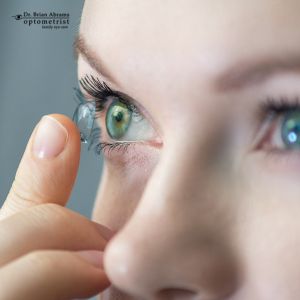The idea of contact lenses has been around since Leonardo Da Vinci proposed a similar idea in the early 16th century. The first device that we would consider a contact lens by today’s standards was a small ocular lens created by a German glassblower that was fitted to a patient in late 19th century Germany. Since then, contact lenses have become widespread in their popularity and utility. In Canada alone, the market for contact lenses is over $2 billion! Contact lenses are advantageous over a pair of glasses because of their versatility, especially in humid areas, for people who work in cold climates, for usage in active settings like organized sports, or simply because they aren’t visibly noticeable on your face. If you require contact lenses, consider contacting Dr. Brian Abrams, an eye doctor in Vaughan. Call now to book a contact lens eye exam!
How Do Contact Lenses Work?
The one disadvantage of contact lenses compared to glasses is that contact lenses can cause infection if the user doesn’t take the proper precautions. Contact lenses are placed directly on the cornea, so any bacteria or other potentially infectious agents they may become contaminated with are placed on the cornea as well. Contact lenses create a seal around the eye, which prevents proper flushing of the eye with natural defences like tears and allows bacteria to proliferate.

How to Care for Your Lenses
Since the first contact lenses were developed from thin glass, the production and storage of contact lenses has changed. Modern contact lenses are made of various types of plastic, which allows them to be fitted comfortably over most eyes and stored in sealed containers in a saline solution to ward off contamination. Proper care must still be taken to ensure that your contact lenses are properly sterilized. One easy way to accomplish this is to pay attention to the shelf life of your contact lenses. Although contact lenses come sealed in saline solution, the manufacturer has stamped the case with an expiry date because over time, the seal can become compromised and the manufacturer can no longer guarantee the safety and sterility of the contact lenses.
Evaluate the Shelf Life
Another way to evaluate the shelf life of your contact lenses is to examine the recommended duration of wear. Not all contacts are created equal; there are daily-use contacts, bi-weekly, monthly’s, 6-month contacts, or even contact lenses that you don’t need to replace for a year. Different lenses are made of different materials, and the big component that distinguishes their longevity of usage is their permeability – specifically to oxygen. Throughout wearing contact lenses, your eyes will become slightly deprived of oxygen. This is why you may notice that your eyes are a bit redder than usual at the end of the day while wearing your contacts. This is perfectly normal and not harmful to your eye if you’re following the manufacturer’s instructions for usage. A common example of poor usage would be if a patient who uses daily contact lenses sleeps with their lenses on and goes days without changing them. The lack of permeability for the user’s eyes will be harmful, and the user will become more prone to an infection.
Avoid Contact Lens Mishaps with Dr. Brian Abrams
Essentially, the key to proper contact lens usage and safety is to follow the instructions on the box. Contact lenses provide freedom that glasses simply can’t deliver, so if you’re thinking of getting contact lenses, be sure to consult with your eye doctor in Vaughan first. Different eyes function better with different lenses, so it’s important to test a few options before you make your purchase. Contact Dr. Brian Abrams to book a contact lens eye exam!


